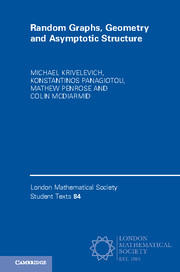1 - Long paths and Hamiltonicity in random graphs
Published online by Cambridge University Press: 05 May 2016
Summary
Introduction
Long paths and Hamiltonicity are certainly among the most central and researched topics of modern graph theory. It is thus only natural to expect that they will take a place of honor in the theory of random graphs. And indeed, the typical appearance of long paths and of Hamilton cycle is one of the most thoroughly studied directions in random graphs, with a great many diverse and beautiful results obtained over the past fifty or so years.
In this survey we aim to cover some of the most basic theorems about long paths and Hamilton cycles in the classical models of random graphs, such as the binomial random graph or the random graph process. By no means should this text be viewed as a comprehensive coverage of results of this type in various models of random graphs; the reader looking for breadth should rather consult research papers or a recent monograph on random graphs by Frieze and Karoński [1]. Instead, we focus on simplicity, aiming to provide accessible proofs of several classical results on the subject and showcasing the tools successfully applied recently to derive new and fairly simple proofs, such as applications of the Depth First Search (DFS) algorithm for finding long paths in random graphs and the notion of boosters.
Although this chapter is fairly self-contained mathematically, basic familiarity and hands-on experience with random graphs would certainly be of help for the prospective reader. The standard random graph theory monographs of Bollobás [2] and of Janson et al. [3] certainly provide (much more than) the desired background.
This chapter is based on a mini-course with the same name, delivered by the author at the LMS-EPSRC Summer School on Random Graphs, Geometry, and Asymptotic Structure, organized by Dan Hefetz and Nikolaos Fountoulakis at the University of Birmingham in the summer of 2013. The author would like to thank the course organizers for inviting him to deliver the mini-course, and for encouraging him to create lecture notes for the course, which eventually served as a basis for the present chapter.
- Type
- Chapter
- Information
- Random Graphs, Geometry and Asymptotic Structure , pp. 4 - 27Publisher: Cambridge University PressPrint publication year: 2016
References
- 9
- Cited by



